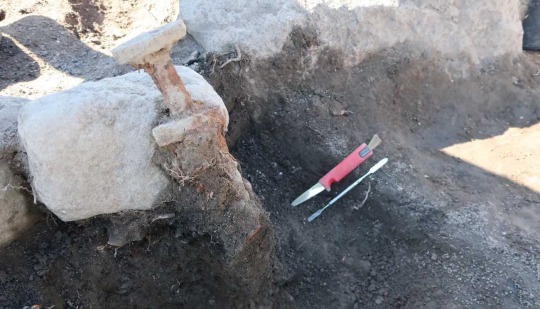#viking sword
Text

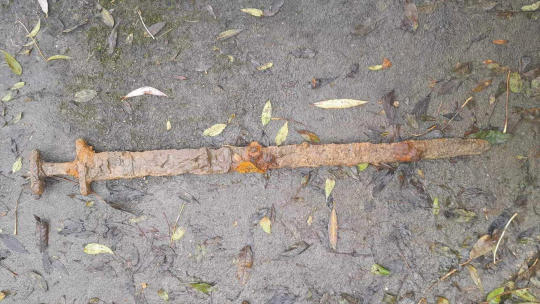
1,100-Year-Old Viking Sword Found in UK River
A corroded sword pulled from an English river by a magnet fisher is a Viking weapon dating to between A.D. 850 and 975, experts have confirmed.
Trevor Penny was searching for lost and discarded objects in the River Cherwell in Oxfordshire in November 2023 when he made the discovery. The magnet fisher had been down on his luck that day and only pulled scaffolding poles from the water, he said in a message on Facebook. When Penny lugged out the sword, he didn't immediately recognize what it was.
"I was on the side of the bridge and shouted to a friend on the other side of the bridge, 'What is this?'" Penny, who is a member of the Thame Magnet Fishing Facebook group, recalled in the message. "He came running over shouting, 'It looks like a sword!'"
Penny immediately uploaded images of the sword to Google to try to identify it. "Whatever photo angle I tried was coming up with Viking sword," Penny said. The magnet fisher then contacted the Oxfordshire county liaison officer responsible for recording archaeological finds made by the public, and took the sword to be examined by experts.


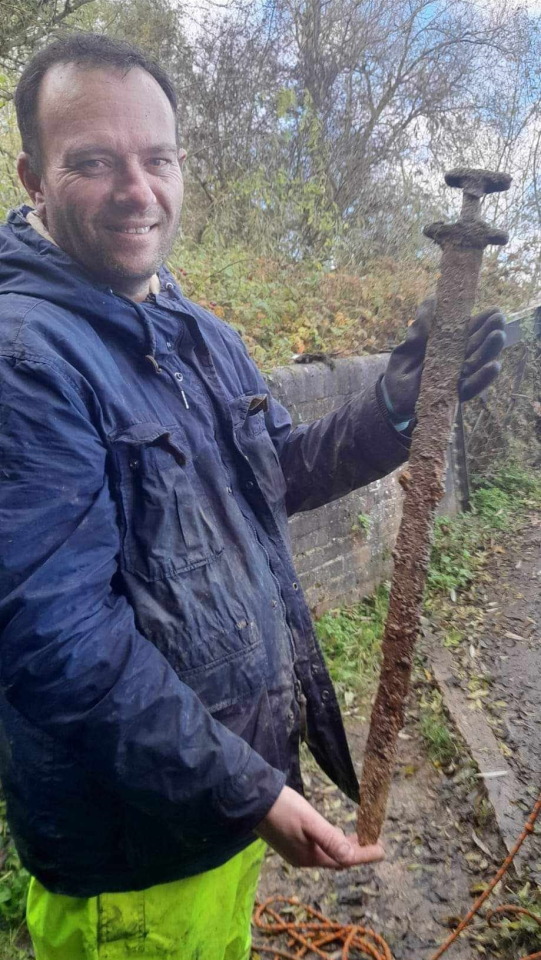
The sword, only provisionally dated until now, has been authenticated as Viking and estimated to date as far back as 1,200 years ago.
The weapon dates to a period when the Vikings, who were originally pagans from Scandinavia, traveled to the British Isles to plunder, conquer and trade with the ruling Saxons. The Vikings set foot on British soil in the eighth century, having raided a monastery on Lindisfarne, an island off Britain's northeast coast, in 793. Similar raids in Britain occurred for several centuries and escalated after 835, when larger Viking fleets started arriving and fighting royal armies. British kings gradually reconquered territory seized by the Vikings throughout the 10th century and unified what was a patchwork of kingdoms into a new realm called Englalond.
Viking incursions and periods of rule continued until the 11th century, but the Viking Age ended following the Battle of Stamford Bridge in 1066, with the defeat of the king of Norway, Harald III Sigurdsson, by the Saxons.
The newly discovered Viking sword is in the care of Oxford museum services and may eventually be put on display, the Oxford Mail reported.
"The officer said it was archaeologically rare to find whole swords and treasure of historical importance still intact," Penny told the regional newspaper last week. "There was a little dispute with the landowner and the rivers trust who don't permit magnet fishing. The latter sent a legal document saying they wouldn't take action on the condition that the sword was passed to a museum, which I had done."
By Sascha Pare.
#1100-Year-Old Viking Sword Found in UK River#River Cherwell#magnet fisher#sword#viking sword#ancient artifacts#archeology#archeolgst#history#history news#ancient history#ancient culture#ancient civilizations#vikings#viking history
251 notes
·
View notes
Text

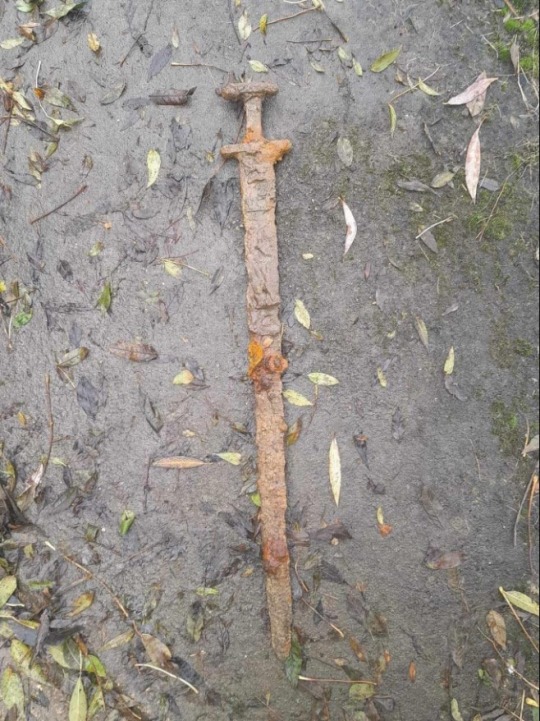
🗡 Rare 1,100-year-old Viking sword was discovered in the River Cherwell, Oxfordshire
Experts have confirmed that a corroded sword pulled from a river in Oxfordshire at the end of last year is an "archaeologically rare" Viking weapon dating to between A.D. 850 and 975.
Image credit: Trevor Penny
More info 👉 https://www.livescience.com/archaeology/vikings/1100-year-old-viking-sword-pulled-from-uk-river-by-magnet-fisher
- -
🗡 Меч викингов случайно выловили из реки Черуэлл (Оксфордшир, Англия)
Эксперты подтвердили, что меч, найденный в реке в Оксфордшире в конце прошлого года, является «археологически редким» оружием викингов, датируемым периодом между 850 и 975 гг. н.э.
Ссылка на источник 👉 https://www.livescience.com/archaeology/vikings/1100-year-old-viking-sword-pulled-from-uk-river-by-magnet-fisher
#Vikingsword #sword #меч #Мечвикингов #викинги #Viking #archaeology #археология #history #история
#vikings#viking#medieval#средневековье#middleages#history#история#sword#viking sword#меч#викинги#меч викинга#археология#archeology
70 notes
·
View notes
Text
.Viking Swords - Haithabu / Hedeby.
Three swords from the same burial mound of a Viking age man, 10th century. Displayed at the Viking Museum Haithabu, 2009.

View On WordPress
24 notes
·
View notes
Photo


A Viking era Sword inlaid beautifully with brass wire, recovered from Lummelunda, Sweden, ca. 800-1100, housed at the Statens Historiska Museer.
#weapons#sword#viking sword#europe#european#sweden#swedish#gotland#viking era#statens historiska museer#art#history
288 notes
·
View notes
Text

"I need my golden crown of sorrow,
My bloody sword to swing,
My empty halls to echo with grand self-mythology
I am no mother, I am no bride, I am king."
(King - Florence + the machine)
- 100% fake fur
#viking#vikings#viking woman#viking warrior#viking sword#viking weapons#pagans of tumblr#pagan women#norse paganism#norse pagan#norse#warrior#female warrior#warrior women#wild woman#more wolf than woman#wolf woman#red moon#lunar eclipse#pagan witch#pagan community#paganism#pagan things
40 notes
·
View notes
Text

#handmade knife#avatar: the last airbender#dagger#etsy#handcrafted#crafts#handmade earrings#handmade jewelry#Dagger#chrsitmas#christmas gift guide#gift ideas#gift for her#gift art#gift for him#gift for mom#christmas gifts#holiday gifts#unique gifts#viking sword
2 notes
·
View notes
Text




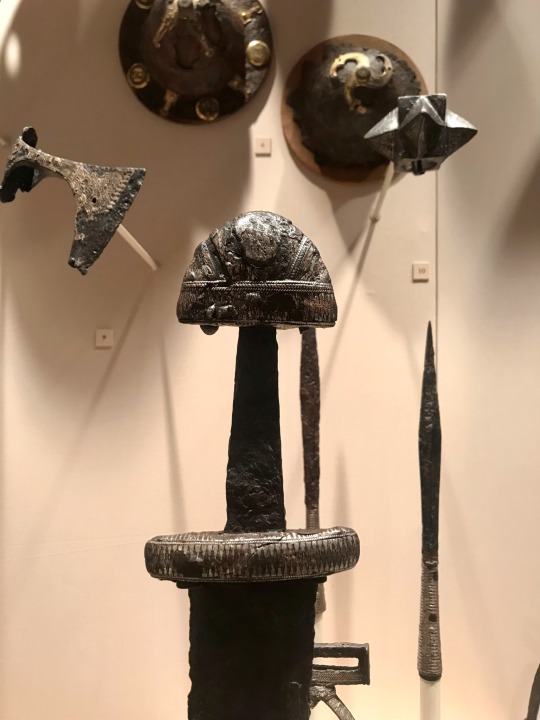
Upon careful observation, one will see that the the pommels of these Viking Age sword are crooked; more noticeably on the center sword. This was a deliberate feature incorporated by the craftsman to allow for optimal grip ergonomics and biomechanics. Linked is a video by Roland Warzeca on grip ergonomics @ 7:35.
11. Sword
Steel, copper, silver, niello
Weight, 2 lb. 4 oz. (1020 g)
European, probably Scandinavian,
about 900-1000
12. Sword
Steel, iron, silver, copper alloy
Weight, 3 lb. 5 oz. (1497 g)
Germanic or Scandinavian, about 850-900
This blade is inlaid in iron with +VLFBEHRT+, indicating that it was made or inspired by the swordsmith Ulfberht. He is thought to have worked in the Middle Rhine region of Germany, and his blade-making style and signature were emulated for generations.
13. Sword
Steel, silver, copper alloy
Weight, 2 lb. 10 oz. (1177 g)
Scandinavian, about 950-1000
Displayed at The Metropolitan Museum of Art, New York City, United States.
youtube
4 notes
·
View notes
Text




Viking seax dedicated to Tyr, god of war and justice
53 notes
·
View notes
Photo
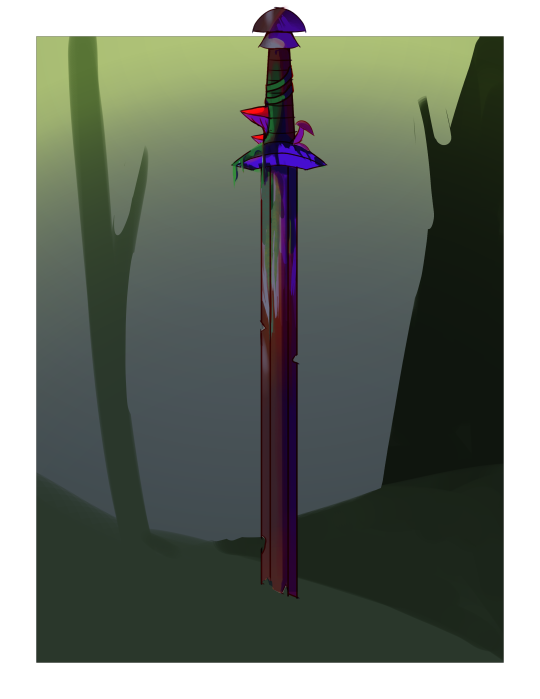
life surrounds death, death surrounds life
swordtember day 21- decay
14 notes
·
View notes
Text



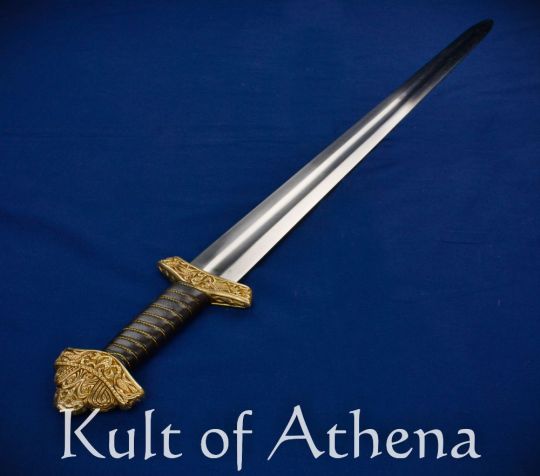
Del Tin Viking Sword
The Del Tin Viking Sword features a double edge blade with wide cental fuller. The guard and pommel are made of lost wax cast bronze and feature detailed designs. The grip is hard wood with a leather wrap completed with inlaid braided brass wire. The unsharpened blade is made of well tempered Chrome-Vanadium steel with a hardness of 50HRC and is peened at the pommel for durability.
#Kult of Athena#KultOfAthena#New Item Wednesday#Del Tin#Del Tin Viking Sword#Viking Sword#Viking Swords#sword#swords#weapon#weapons#blade#blades#Viking#Vikings#Viking Age#Dark Age Swords#Dark Ages#European Swords#European Weapons#Dark Age Weapons#Viking Weapons
3 notes
·
View notes
Photo

A VIKING IRON AND COPPER-ALLOY SWORD
CIRCA 9TH-10TH CENTURY A.D.
37 in. (93.9 cm.) long.
Viking warrior graves were flush with weapons, preserving swords that provide important information about their weaponry. It illuminates their hierarchical culture, illustrating that those of higher-status could afford both to own swords and to bury their weapons with them for eternity. It has also shared the emphasis on individuality and desire to use decorative embellishments where possible. Some were adorned with pattern-welded ornate hilts and pommels, of different shape and decoration.
While there were single-edged swords, double-edged swords such as the present example were more common, which were used for slashing. Predominantly they were formed from a single piece of metal but some were pattern welded from multiple rods and twisted together to give a decorative core to the blade; this technique became rarer after the 9th century.
The sword presented here has a long iron blade, narrowing gracefully to its point. Its hilt and pommel are separately made, formed of copper alloy; the plain hilt is slightly curved towards the blade and the pommel is pyramid-shaped.
#A VIKING IRON AND COPPER-ALLOY SWORD#CIRCA 9TH-10TH CENTURY A.D.#vikings#viking sword#viking weapons#ancient artifacts#ancient weapons#history#history news#ancient history#ancient culture#ancient civil#viking history#viking culture
65 notes
·
View notes
Text
Such a beautiful thing.
#ancient Norway#Stavanger#Viking sword#Viking voyages#Jåttå/Gausel#Jåttå#Gausel#archaeology#conservation
10 notes
·
View notes
Video
youtube
Sword Fighting As It Was For the Vikings
0 notes
Text
The long, thin piece of metal looked like a scaffolding pole when Trevor Penny saw it on the banks of an English river last November.
That would not have surprised Mr. Penny, who, while practicing his magnet fishing hobby, has unearthed household items, tools and other metal debris from the waterways near his Oxfordshire home. (Magnet fishing is pretty much what it sounds like: A strong magnet is attached to a rope, which is then tossed into a body of water.)
But his find that day was much more dramatic: a rusty Viking sword that had been there for more than 1,000 years.
The sword, found in the River Cherwell and identified by an archaeological group that tracks public finds, most likely dates to a period between 850 A.D. and 975 A.D. Mr. Penny said he handed it over to the Oxfordshire Museums Service this week, where it is expected to be put on display after restoration.
The discovery evokes a medieval era during which Vikings landed in the British Isles, raiding, plundering and trading their way through England and Scotland. Their incursions did not last, but their descendants still make up part of the British population today. In recent years, metal detectorists have helped unearth artifacts and treasure that had lain buried underground for centuries.
Detectorists in 2007 found a hoard of Viking treasure near North Yorkshire that experts called one of the most significant finds in Britain. Another hoard buried during that era was discovered in 2014 in Galloway, Scotland. But not everyone who stumbles across such discoveries has been immediately transparent: Two men in 2019 were convicted of theft and ordered to pay $1.5 million after they concealed the discovery of an Anglo Saxon hoard of treasure and sold some of the items.
When Mr. Penny, 52, realized what he had found, he contacted a local official responsible for identifying the public’s archaeological finds.
The discovery was “one further puzzle piece that can cast light on our shared heritage,” said that official, Edward Caswell, who documents Oxfordshire finds for the Portable Antiquities Scheme run by the British Museum. More analysis was needed, he cautioned, but experts confirmed that the sword fit with others from that era.
“We do find Viking weapons, including swords, deposited in rivers in England,” said Jane Kershaw, an associate professor of archaeology at the University of Oxford. About 70 such swords have been found in Britain, she said, and while Mr. Penny’s sword might have been dropped by accident, they were also often intentionally thrown in waterways as part of a ritual.
“Rivers were seen as gateways to other worlds, where gods and other creatures or spirits might live,” she said, adding that archaeologists interpreted such rituals as a Viking plea for protection or luck, perhaps in battle.
Many such weapons have been found in the north and east of the country, Dr. Kershaw said. She called the sword a “rare example” of viking activity in the area.
“It is outside the normal find zone for these weapons,” she said. “But the Vikings, they were active in that area. There is a lot that we don’t know about their activities.”
Hobbyists are increasingly making important discoveries, and Dr. Kershaw said it was critical that they report their finds. “It’s hugely valuable information,” she said. “As long as they are recording it, this is having archaeology that otherwise would be lost.”
But who owns artifacts that are found today can be a thorny issue, and can depend on whether they are classified as “treasure.”
According to the Treasure Act in Britain, metal objects more than 300 years old when found must be reported to the authorities within two weeks. Museums have the chance to claim objects, and finders and landowners may receive a reward, after an object is valued if it is deemed to be a treasure.
Mr. Penny found the sword on land owned by the Canal & River Trust, a charity that manages many of England’s inland waterways. The group has banned magnet fishing on its property, saying that it can be “dangerous” and that sharp objects could cause problems for visitors.
But the charity called the sword an “exciting find,” and it has agreed with Mr. Penny to transfer any potential ownership rights over the sword to a local museum.
Since he began magnet fishing three years ago, Mr. Penny has helped dredge up other discoveries, including old railway tools and a grenade suspected to be from World War II that had to be safely detonated by the authorities.
“It’s a great way to meet people,” said Mr. Penny, who often brings the metal he collects to a local scrapyard. “We get to talk to lots of people passing, who all thank us for cleaning the environment.”
He posts about his finds to a local magnet-fishing group, and so far has no plans to stop.
“I will keep fishing,” Mr. Penny said. “Hopefully with permission to do so.”
0 notes
Text
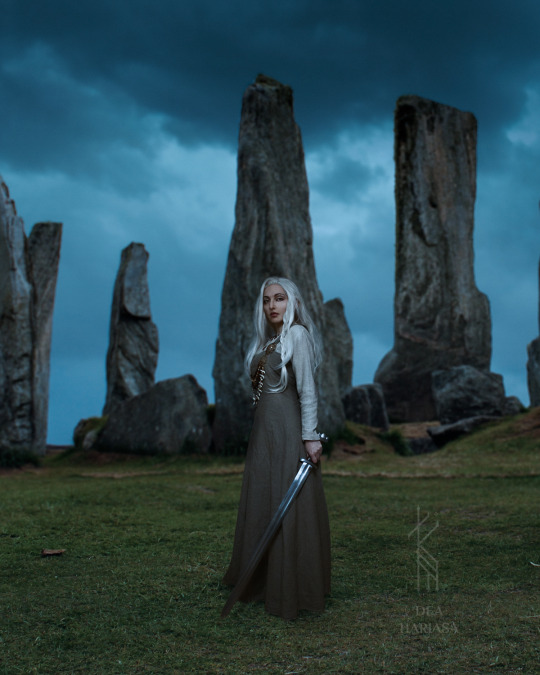
Among ancient giants
❖ Etsy Shop ❖ Instagram ❖ Facebook
#shieldmaiden#women with swords#viking age#viking dress#viking#viking sword#pagan witch#paganism#paganart#modern paganism#witch#norse paganism#norse pagan#norse witch#seidr#fantasy core#fantasy art#valkyrie#pagan community#paganblr#witchblr
13 notes
·
View notes

